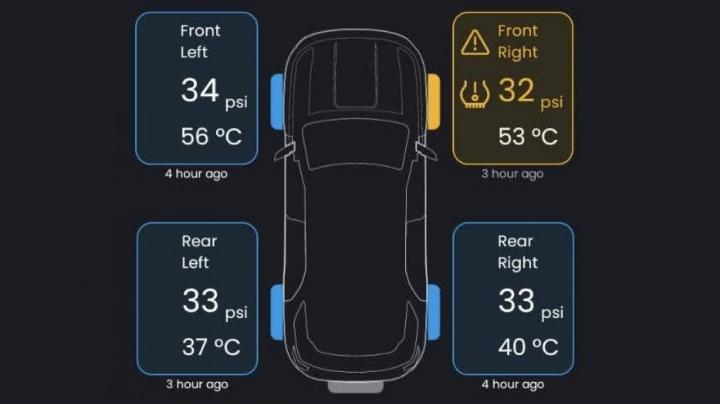News
Are tyre pressure monitoring systems reliable, useful or dependable?
In this era of tubeless tyres that don't lose air rapidly, do we really need an unreliable system to tell us when we have low pressure?
BHPian ruskinash recently shared this with other enthusiasts.
I wanted to understand if your Tyre Pressure Monitoring systems are accurate/reliable, or if you've been having any issues with them.
The factory-fitted left front sensor on my i20 indicated a pressure reading of 29 and flashed a low tyre pressure banner and the telltale/TPMS malfunction indicator turned on.
I made a stop at my regular fuel station to top up the air on all my tyres to the standard 33psi. I knew I had to drive for a bit to let the TPMS update the readings. Although the left front indicated the new pressure the telltale and the TPMS malfunction kept glowing. I referred to the manuals for further insight, and here's what it said.
As an added safety feature, your vehicle has been equipped with a tyre pressure monitoring system (TPMS) that illuminates a low tyre pressure telltale when one or more of your tyres is significantly under-inflated.
It does not provide information on what it means by "significantly" underinflated. A quick search on Google suggested that the TPMS indicates a low-pressure warning when there is a 25% or more pressure loss. In my case, the triggering figure would be 24.75psi, not 29psi.
The manual further states:
Your vehicle has also been equipped with a TPMS malfunction indicator to indicate when the system is not operating properly. The TPMS malfunction indicator is combined with the low tyre pressure telltale. When the system detects a malfunction, the telltale will flash for approximately one minute and then remain continuously illuminated. This sequence will continue upon subsequent vehicle start-ups as long as the malfunction exists. When the malfunction indicator is illuminated, the system may not be able to detect or signal low tyre pressure as intended. TPMS malfunctions may occur for a variety of reasons, including the installation of replacement or alternate tyres or wheels on the vehicle that prevents the TPMS from functioning properly. Always check the TPMS malfunction telltale after replacing one or more tyres or wheels on your vehicle to ensure that the replacement or alternate tyres and wheels allow the TPMS to continue to function properly.
From the above, it appears that it is a TPMS malfunction and I need to get it rectified from Hyundai. Fair enough. Then it spins a googly with the following:
If there is a malfunction with the TPMS, the low tyre pressure position telltale will not be displayed even though the vehicle has an under-inflated tyre.
In my case, the telltale is being displayed, AND my tyre isn't under-inflated. So is it a TPMS failure or not?
The more I read about the TPMS in the manuals the more I feel it is a nuisance feature, as it lays out all the possible scenarios on how a TPMS may not be reliable.
The TPMS malfunction indicator may be illuminated if the vehicle is moving around electric power supply cables or radio transmitters such as at police stations, government and public offices, broadcasting stations, military installations, airports, or transmitting towers, etc. This can interfere with the normal operation of the Tire Pressure Monitoring System (TPMS).
The TPMS malfunction indicator may illuminate if snow chains or some separately purchased devices such as notebook computers, mobile chargers, remote starters, navigation etc., are used in the vehicle. This can interfere with the normal operation of the Tire Pressure Monitoring System (TPMS).
From the above, it is clear that more could go wrong than right, so why provide the feature at all?
If a certain system is provided, I expect it to function reliably and accurately irrespective of the conditions. Including a half-baked feature that is often unreliable turns it into an annoyance.\
And finally,
Please note that the TPMS is not a substitute for proper tyre maintenance, and it is the driver’s responsibility to maintain correct tyre pressure, even if under-inflation has not reached the level to trigger illumination of the TPMS low tyre pressure telltale.
Yes, that's exactly how it's always been! In my three and a half decades of driving, I never thought I needed a system to inform me about low tyre pressure. I always check my tyres before driving. While I see the value of an accurate and reliable system, are we there yet?
My question to fellow BHPians is: in this era of tubeless tyres that don't lose air rapidly, do we really need an unreliable system to tell us when we have low pressure? And, do you feel TPMS is Useful/Dependable?
Here's what GTO had to say on the matter:
My Thar has real-time TPMS which is excellent! Shows the tyre pressure & temperature.
On the other hand, the BMW 530d has the junk indirect TPMS which relies on the ABS sensor. I only get puncture / low pressure notifications at higher speeds (70 - 80 kmph). With runflats, this is even more dangerous as there are no visible signs of lower air pressure.
Manufacturers still using indirect TPMS are stupid.
Here's what BHPian electric_eel had to say on the matter:
By any chance is your TPMS an indirect TPMS, i.e. it uses the ABS sensor to detect a difference in tyre speed and flags error? The factory-fitted TPMS in my Nexon EV is an indirect TPMS.
In the case of an indirect TPMS, you need to reset the TPMS after you have fixed any problem with the tyre (if there is any).
Here's what BHPian saket77 had to say on the matter:
This is more of a deflation warning system than an actual TPMS. However, that spares us the headache of changing the batteries inside the tyre/valves. This system works by comparing car speeds/wheel speeds. A deflated tyre will have a smaller circumference and will rotate faster than others/ given car speed. The deflation warning system works on this principle. The demerit of the system is that it will not show tyre pressures in numbers and only alert the driver in case a tyre is deflating/ or has less air pressure.
In an i20, actual tyre air pressures are shown on the MID. I believe it should have sensors inside the tyres and hence be an active TPMS system. I have not measured how accurate are the numbers though.
Check out BHPian comments for more insights and information.
- Tags:
- Indian
- Member Content
- TPMS









.jpg)









